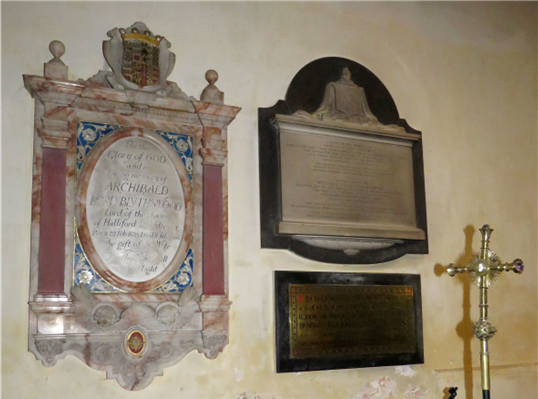By Bob Speel, Church Monument Researcher
There are over 40 ancient churches in West London surviving from the lost county of Middle-sex, with St Nicholas Church in Shepperton the most southerly. Like most of them, it contains interesting wall monuments. Visiting churches to see the monuments is not a hobby to pursue now, alas, but here is a taster of what there is to see once it is safe to do so.
The Saxons settled here and a stone church was on the site by the 12th or early 13th Century. That was lost to flooding, it is said, and what we see today, a small cross-shaped or cruciform building, dates from 1614, reusing rubble from the earlier church. Often the tower of a church is the oldest part, but here the small, brick tower is a 1710 replacement initiated by (and largely paid for) by the Rector, Revd. Lewis Atterbury. Notable features are out-side staircases to the little galleries in the north transept (18th Century) and Nave (early 19th Centu-ry), and a 1930s refurbishment brought the vestry on the south side. The result overall is pleasingly irregular and picturesque.
Inside, the oldest tablet on the walls of the Church is to Diana Bray, d.1743, made of white marble with a strong grey streak, and with a contrasting black and white marble for the flat pillars (pilasters) to each side, which support a heavy shelf above. Those distinctively streaked marbles are characteristic of the later 18th Century, and can be seen again in the tablet to Thomas Thomas Jr, thirty years later, which also has a triangular pediment.
By the 19th Century, the characteristic type of smaller wall monument, still Classical, is of pure white marble on a black backing panel, and most of the tablets in St Nicholas church are of this type.
Mrs Barbara Baron, d.1802, has a long inscription recording that ‘From [her] firm Base of TRUE CHRISTIAN FAITH / Sprung the glorious Super-structure of GOOD-WORKSs / And Afforded a rich Display of every SOCIAL, MORAL / And RELIGIOUS DUTY…’ The piece bears a carved Aladdin’s-lamp style wide funereal urn, and at the base is the family shield of arms. It is signed by a significant sculptor, John Bacon Junior, who a few years later completed the grand statue (designed by his more illustrious father) of King William III in St James Square. Bacon Jr has some monuments with figure sculpture elsewhere in old Middlesex churches, for example a mourning girl in Twickenham church, and two female figures in West Drayton, as well as in churches southwards across the Surrey border.
In St Nicholas Church, we have one little carved figure, indeed a whole miniature scene, on the panel to Sarah Chapman, d.1831 – with a nicely draped Classical female resting against a tomb with pot on top; she holds an upturned torch, symbol of life snuffed out, and we see a dying tree in front of her, and a snapped off trunk behind.
From the 1890s, the Arts and Crafts period brought a new type of more colourful and decorative monu-ment, and St Nicholas church has a particularly fine one in the panel to Archibald Lord Blythswood, Lord of the Manor of Halliford, Middlesex (see below).
This splendid piece is carved from pinky-brown alabaster, a favourite material of the Arts and Crafts artists, with carved winged-cherub heads and foliage at the base, and mother-of-pearl flow-ers against deep blue in the corners, and a gilt shield of arms on the top.
I hope this short description has whetted your appetite for an exploration of the church once lock-down is a memory.

